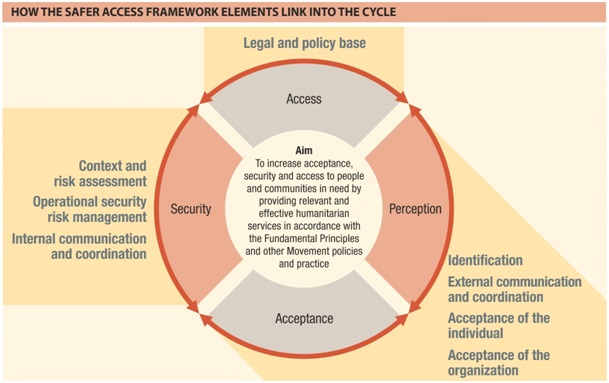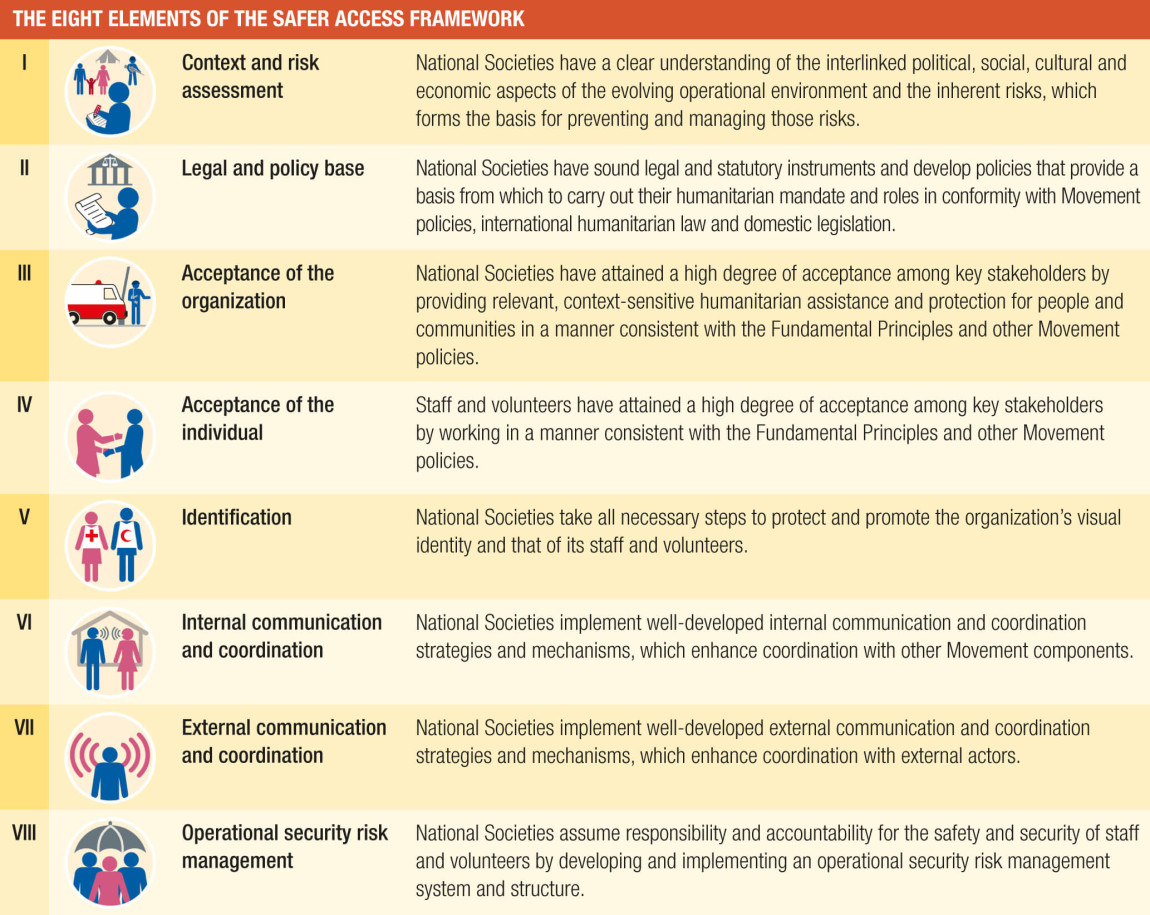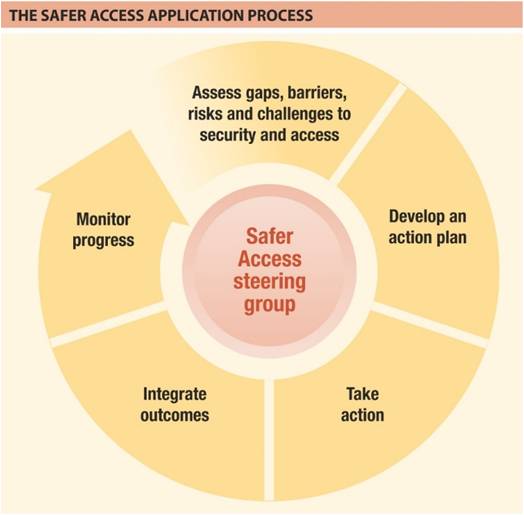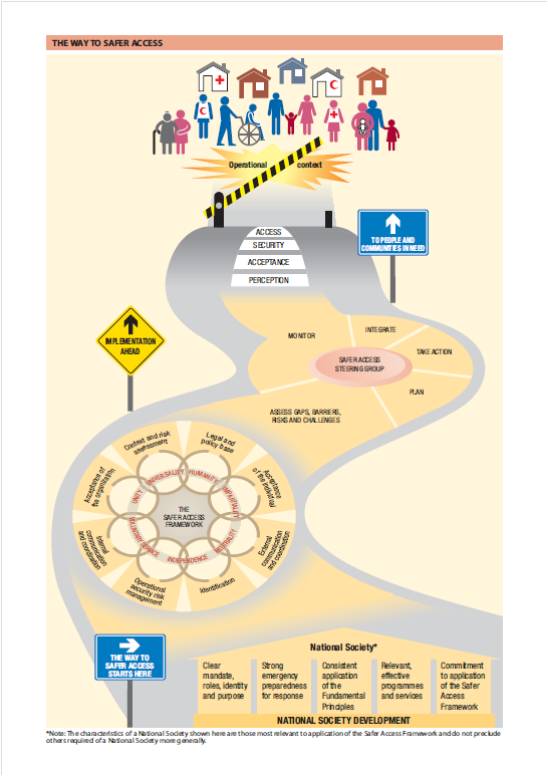In a nutshell…
The Safer Access Framework (SAF) is comprised of eight sections (elements) containing actions and measures, that, if taken by a National Society, according to context-specific priorities, will increase its acceptance, security and access to people and communities in need. Each of the eight elements of the SAF are like parts of a chain: interlinked and interdependent.
Actions taken or not taken in connection with one element may therefore often have an impact on the others. A chain is only as strong as each link in it; should one link be weak or break, it would have a negative effect on the chain as a whole.
Click here to access the above video in the following languages: Chinese, Farsi, Spanish and Russian.
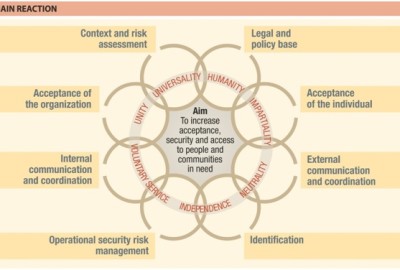
The Framework is underpinned by the Safer Access Cycle – access, perception, acceptance, and security – and reinforced through the concrete use of the Fundamental Principles to guide operational communication and decisions.
The Framework was developed by ICRC together with over 50 National Societies and is based on their experiences and input.
In preparing to extend our reach safely, we have found the Safer Access Framework an extremely useful lens through which to examine ourselves, the external environment and the work we need to undertake to overcome the barriers faced by vulnerable people in accessing humanitarian services.
Sharon Sinclair, Operations Director Northern Ireland, British Red Cross Society
Underpinning the SAF: The Safer Access Cycle
The elements are underpinned by the Safer Access Cycle – access, perception, acceptance and security.
Achieving safer access can be seen as a perpetual cycle. When access (proximity to the community) already exists or is allowed by gatekeepers, the delivery of effective and relevant community-based humanitarian services, carried out in accordance with the Fundamental Principles and other relevant Movement policies, will positively influence perceptions of the National Society and help build strong relationships with community members.
These will in turn increase the National Society’s acceptance by the community, gatekeepers and other stakeholders and ultimately its security and further access, especially in contexts where insecurity is heightened and access may be restricted.
It should be emphasized that in very insecure contexts, these measures are often not enough. National Societies would benefit from investing in the development of a thorough and professional operational security risk management system designed to identify operational risk and prevent, mitigate and manage it effectively.
When perceptions of the National Society or its people are not positive enough to contribute toward increased acceptance and safer access, concrete actions need to be taken by the National Society. If actions are not taken, they could very well manifest to a level that blocks access or results in security incidents. These actions are found in the Safer Access Framework.
1Access
Guiding Questions
- Is the National Society already widely known for the provision of relevant neutral, impartial and independent humanitarian activities?
- Is the National Society present throughout the territory and able to access all people and communities through its staff and volunteers?
2Perception
Guiding questions
- Does the National Society have mechanisms in place to continually gauge how key stakeholders, including gatekeepers, perceive it and its staff and volunteers in relation to neutrality, impartiality and independence and how its services are valued?
- Does the National Society have a systematic approach, and the tools and procedures in place, to clarify perception issues and to address misperceptions or adjust its programming or the behaviour of its staff and volunteers as required in a timely way?
3Acceptance
Guiding questions
- Do community members and leaders and other stakeholders view the humanitarian programmes and services delivered by the National Society as relevant to meeting the community’s needs?
- Is the National Society known, valued and viewed as impartial and able to act autonomously?
- Does the National Society have a process for screening its partners in order to maintain its reputation as impartial, neutral and independent?
- Does the National Society invest in building solid relationships of trust and credibility with the people and communities it serves, involving them in decision-making and in other ways throughout all phases of programme design and delivery?
- Are programmes delivered in a way that brings communities together and does not create divisions?
- Is there any domestic legislation criminalizing activities carried out in support of terrorist activities? What are/could be the consequences or impact of such legislation on the activities of the National Society?
4Security
Guiding questions
- Do the people, communities, key stakeholders and gatekeepers in the areas where the people are most in need have a positive perception of the National Society and its staff and volunteers and is this demonstrated by a high degree of acceptance, access and security?
- Is the National Society able to contact key stakeholders to negotiate assurances from them for safe passage for its staff, volunteers and vehicles? Is there legislation in place that might prevent it from doing so?
- Does the National Society have a systematic and professional approach to operational security risk management (including proper identification of the National Society’s staff and volunteers, facilities and transports with the Society’s logo or the protective emblem) and are its people adequately trained and insured?
1KEY POINTS
- Achieving safer access to people and communities in need is the goal of a perpetual cycle that begins with the delivery of effective and relevant humanitarian services, in accordance with the Fundamental Principles and other Movement policies.
- The way in which an organization and its personnel are perceived has a direct impact on its acceptance and therefore on its ability to deliver humanitarian assistance safely.
- In sensitive and insecure contexts, fear and suspicion may adversely affect previous good relations and positive perceptions requiring specific actions and measures to rebuild trust and acceptance.
- Sound operational security risk management practices complement measures taken to improve perceptions and increase acceptance by ensuring that risks to staff, volunteers and beneficiaries are identified, mitigated and managed appropriately.
The Safer Access Framework: the eight elements
The Safer Access Framework (SAF) is a context-specific, operational and principles-based approach toward National Society development and emergency preparedness and response.
It contains eight elements, each focusing on a key area (see Table below). Each area brings together a number of preparedness actions and positioning or active acceptance measures, many grounded in the Fundamental Principles that have been shown to help National Societies increase their acceptance, security and access to people and communities with humanitarian needs in sensitive and insecure contexts.
Most of the ideas underpinning the SAF are not new to National Societies as they concern various familiar organizational development or emergency preparedness and response actions. However the method of using the Framework as a useful lens through which to examine operational lessons learned, the context and the gaps, challenges and risks it may pose leads to a clear prioritized set of actions required to address their root causes.
The SAF elements are interlinked and interdependent. For instance, an ongoing context and risk assessment process and appropriate internal communication systems and technology are crucial to developing an effective operational security risk management system. An external communication plan to increase acceptance of the organization depends on a prior understanding of how the National Society is already perceived and its existing level of acceptance. Preparing personnel to respond in a sensitive or insecure context requires, among other things, their knowing how to conduct a thorough context and risk assessment, being familiar with the National Society’s legal and policy base to guide actions, and being trained in the code of conduct and security guidelines, as well as protective and other measures, all of which will enhance the acceptance of the individual.
The experience of many National Societies in applying the SAF in a range of different contexts has led to the observation that although the SAF is particularly relevant to their work in sensitive and insecure contexts including armed conflict and internal disturbances and tension, the proposed actions and measures are also of benefit for their day to day activities.
Safer Access Framework – what it is and is not |
||||||||
What it is |
What it is not |
|||||||
| An operational approach to development, preparedness and response | A training ; the application process can result in developing contents for training purposes | |||||||
| Actions and measures to be taken well in advance of a response to position and prepare the National Society, as well as during | Just a response tool – many actions need to be taken well before a response to pave the way for safer access | |||||||
| Context-specific actions to increase acceptance, security and access | Only an approach to security management | |||||||
| Applicable at all times for all National Societies | A replacement of Stay Safe or Staying Alive | |||||||
| An approach that requires the full engagement and leadership (all levels) of a National Society’s governance and senior management including programme and branch | A responsibility of one department | |||||||
| Intended to be applied Society-wide | A tool only for response volunteers | |||||||
| An approach intended to be integrated into the National Society’s policies, strategic plan, strucutures, systems, programmes and practice | A separate process within a National Society | |||||||
Initially, the SAF was seen only as a tool for volunteers who worked in the ambulance service, but following approval of the SAF by the National Society leadership in 2012 it is now applied and promoted across all staff levels.
Our Selected Experience: Mexican Red Cross
Many of the actions are best taken well in advance of an operational response and involve building and maintaining good relations with local communities, armed actors and other relevant stakeholders, including gatekeepers. The Framework can also be used as guidance during a response.
We had been working in a peaceful environment for more than three decades when suddenly conflict erupted. We didn’t have much of an idea of how to work in such situations initially. Using the Safer Access Framework, we learned how to increase our access and to increase our risk reduction capacity to work in that kind of situation, which allowed us to reach more people affected by the violence.
Umesh Prasad Dhakal, Executive Director, Nepal Red Cross Society
1KEY POINTS
- The SAF proposes actions and measures that have been tried and tested by National Societies as a means of enhancing acceptance, security and access in sensitive and insecure contexts.
- The recommended actions and measures are grouped under eight “elements” (i.e. key areas) in the SAF.
- The eight elements of the SAF are interlinked and interdependent: actions taken or not taken in connection with one element may often have an impact on the others.
- The SAF is inextricably linked to the Fundamental Principles and focuses on achieving the aim of increasing acceptance, security and access to people and communities in need.
- Some actions and measures have stronger links to one or more concepts of the Safer Access Cycle, but the proposed actions and measures all contribute to the overall goal.
Application of the Fundamental Principles
Despite the distinct operational relevance of the Fundamental Principles, within and outside the Movement they are often perceived first and foremost as an expression of values and ideals. As such, their importance as an operational and decision-making tool is often underestimated.
The Safer Access Framework is grounded in the application of the Fundamental Principles and as such, contains several direct references to the imperative of applying the Fundamental Principles and the critical role that they play in enhancing National Societies’ acceptance, security and access. Specifically, it is spelled out clearly that the Fundamental principles are an effective operational tool that, when applied, guide our thought processes, communication, decision-making and practice.
Adherence to or failure to adhere to the Fundamental Principles may have a direct impact on the beneficiaries and on the security and access of a National Society’s personnel and may have unintended consequences for the Movement as a whole, including at the regional or global level.
It is clear that, in the context of Lebanon, the Fundamental Principles are more than an abstract code or ideological commitment. They serve as a framework for action and an operational tool to guide decision-making in very difficult circumstances. They are of particular relevance to a National Society which needs to balance its role as a formal auxiliary to the public authorities with the ability to provide, and to be trusted to provide, neutral and independent humanitarian assistance for all those who need it most. One of the most important lessons from Lebanon is that this does not come about by accident or without considerable and consistent effort.
Safer Access in Action Case Study: Lebanon
1KEY POINTS
- The work of the Movement is underpinned by the seven Fundamental Principles – humanity, impartiality, neutrality, independence, voluntary service, unity and universality – which inspire and influence its activities.
- The Fundamental Principles are more than a set of ideals and values; they are an effective operational tool that, when applied, guides thought processes, communication, decision-making and practice.
- Consistent adherence to the Fundamental Principles is a primary factor governing National Societies’ ability to gain wider acceptance and thus greater access to affected people and communities in sensitive and insecure contexts. uu To ensure maximum humanitarian impact and a complementary operational approach, a National Society must closely coordinate its preparedness and response actions with all Movement components working in the same context.
- Application of the Fundamental Principles is integral to the SAF. They enjoy an interdependent or symbiotic relationship, through which they support and reinforce each other.
Application of the Safer Access Framework
The Safer Access Framework (SAF) and its application approach and tools are intended to both complement and be part of a National Society’s organizational development and emergency preparedness and response. Although the Framework can be used in an informal manner, it supports a structured assessment and planning process within a National Society that is designed to:
- identify the root causes of the gaps, barriers, risks and challenges to the National Society’s acceptance, security and access through an exploration of the context and operational lessons learned;
- determine the necessary short, mid and long-term actions required to address the gaps, barriers, risks and challenges;
- promote and support the professionalization of the National Society’s operational security risk management approach;
- reinforce the application of the Fundamental Principles.
The assessment and planning process is recommended for all National Societies. It is particularly relevant for those that have already had to respond in sensitive and insecure contexts or are likely to find themselves needing to do so in the very near future. Many of the actions and measures take time to implement so are best taken well in advance of a response. Once initiated, however, they should be part of a permanent process within the National Society so that it can remain responsive to the evolving context and address emerging challenges.
Pre-requisites to a successful Safer Access application process
- Conduct several awareness sessions on Safer Access to stimulate full engagement and commitment to the process
- Full National Society leadership commitment is in place
- Robust support from the ICRC delegation and Movement partners
- Sensitization and engagement of governance, management, programme and branch leadership and key volunteers in the process
- Ground the process in a thorough analysis of the needs, challenges, context, risks and National Society’s existing and desired capacities
- Overcome the ‘it won’t happen here’ mindset and proactively begin to apply the SAF.
- Manage the process: Form a steering group, with a lead focal point, composed of a wide range of governance, management, programme and branch leaders as well as key volunteers
- Assess: Based on a thorough context and risk analysis, identify the root causes of the current/likely gaps, barriers, risks and challenges to your acceptance, security and access.
- Plan and Benchmark: Create an action plan, containing steps that will address the root causes of the challenges and increase the National Society’s acceptance, security and access. Use the Safer Access Benchmarking and Monitoring tool for reference to highlight your current status and provide guidance on future steps to be considered.
- Take action: The steering group and its lead focal point must ensure the priority actions are carried out by the respective persons responsible.
- Integrate results: The outcomes of the actions, whether it be the development of security guidelines, code of conduct or specific training, must be integrated into the National Society’s policies, structures, systems, programmes and practice and staff and volunteers given appropriate guidance and training.
- Monitor: Continue to use the Safer Access Benchmarking and Monitoring tool to monitor progress and adjust your path, in line with the continued context and risk assessment.
Using the Safer Access Framework as a Quick Reference during a response
It is possible for a National Society to use the Safer Access Framework and the tools provided in the midst of an active response, when it may be unable to take the time for a collective effort involving a full assessment and planning exercise. In such a situation, the SAF quick reference chart is a useful tool. The SAF assessment and planning tool could be used to support rapid reflection by providing a format to record gaps, actions and priorities to be addressed.
Although it may not be possible to apply this approach immediately to longer-term actions, the information can be noted for future reference. Meanwhile, spontaneous actions can be taken to resolve urgent and important operational issues that would benefit from a rapid solution.
1KEY POINTS
- Application of the SAF depends on sound National Society organizational development and emergency preparedness for response foundations being in place.
- A National Society would preferably begin to prepare and position itself for acceptance by key stakeholders well in advance of needing to respond in a crisis.
- Before engaging in the SAF application process it is crucial to consider the specific nature of the needs, challenges and risks generated by the context and to take account of the National Society’s existing and desired capacities.
- Different groups within a National Society require different depths of knowledge of the various aspects of the SAF depending on their responsibilities and accountability.
- The ideal application approach consists of a collective assessment and planning process that is based on a sound context analysis (including risks), a reflection on lessons learned and the forecasting of future events.
- The SAF application process should result in short, mid and long-term actions to address the identified gaps, barriers, risks and challenges to safer access and is supported by the SAF assessment and planning tool.
- The process is seen as ongoing and in perpetual motion, responsive to the context and its implications for the National Society’s security and access.
- The SAF benchmarking and monitoring process and tool are useful to determine the National Society’s current status and to track progress in achieving the actions and measures outlined in the SAF.
- The ICRC is on hand to provide National Societies with advisory and technical support in implementing the actions and measures recommended in the SAF, as may be the International Federation and National Societies – particularly those with comparable operational experience or possessing specific technical expertise.
ICRC support for the National Society application process
When planning to engage in or scale up its application of the SAF, a National Society is encouraged to take advantage of the support offered by the ICRC, which remains the focal point of Movement expertise in this area. The ICRC stands committed and ready to support National Societies in
furthering their understanding and application of the SAF. In accordance with the availability of its own resources, the ICRC will support National Societies in their implementation of the SAF by providing advice and, where requested, by co-facilitating the application process.
In contexts where the ICRC, the International Federation and peer National Societies are present, their personnel can provide technical expertise in the actions and measures described in the SAF chart in accordance with their respective capacities and the priorities identified by the National Society undergoing the process. This technical support would of course be provided in addition to programme support, including the traditional areas of ICRC programme capacity-building support such as restoring family links, weapon-contamination awareness and victim assistance, economic security, water and habitat, health and first aid, and human remains management. This capacity-building support is intended to be delivered in a partnership approach.
Contact the ICRC delegation nearest you for further information and to discuss support. Alternatively, send an email to saferaccess@icrc.org for further information or to contribute your experience or tools.
The Way to Safer Access
Achieving safer access does not stop here. There is a wealth of additional information and guidance in the other components of the Practical Resource Pack and in the online Safer Access toolbox sections.
National Societies are also invited to continue contributing their selected experiences and tools developed to support the application of the SAF so that others may draw inspiration from them in their efforts to increase their acceptance, security and access to people and communities in need.

